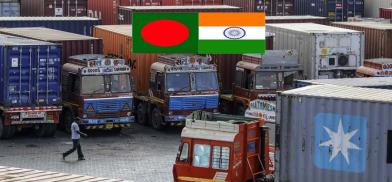India and Bangladesh have a lot to gain by increased trade with each other
The Association of Southeast Asian Nations (ASEAN) and Regional Comprehensive Economic Partnership (RCEP) have tremendous implications for India and Bangladesh because both nations are in the Bay of Bengal Initiative for Multi-Sectoral Technical and Economic Cooperation (BIMSTEC) and South Asian Association for Regional Cooperation (SAARC)

The Association of Southeast Asian Nations (ASEAN) and Regional Comprehensive Economic Partnership (RCEP) have tremendous implications for India and Bangladesh because both nations are in the Bay of Bengal Initiative for Multi-Sectoral Technical and Economic Cooperation (BIMSTEC) and South Asian Association for Regional Cooperation (SAARC).
Bangladesh benefits from reduced tariffs when trading with member nations like the ASEAN Regional Forum. The country may see new opportunities as newer trade blocs like RCEP come into the region. Bangladesh has to negotiate and win trade deals with other neighbouring countries. It would mean RCEP and ASEAN will help to increase the export potential, derive economies of scale, and achieve higher growth. Participating in a new trade deal would help Bangladesh to help reduce prices for the overall realization of economic growth. The nation will be at peace and comfortable in dealing with warring neighbours who are also members of the trade organization.
India, Bangladesh not in RCEP
Both India and Bangladesh are not part of the over 10 nations in Southeast Asia that entered the RCEP trade movement to abolish taxes in the region. RCEP had offered many benefits, including lowering tariffs to its 15 member states of Australia, Brunei, Cambodia, China, Indonesia, Japan, South Korea, Laos, Malaysia, Myanmar, New Zealand, the Philippines, Singapore, Thailand, and Vietnam. Bangladesh investors and traders could have largely benefited by gaining more certainty regarding importing the quality standards from member countries. Importing nations such as China are persuaded to accept the quality standards of other member exporting nations, thereby increasing reliance on the quality of goods offered. Individuals in trade movements will easily navigate or move from one country to the next for trade and investment reasons.
Bangladesh did not join the partnership primarily to safeguard its revenue generation from import dutiess. On why India has not joined the China-initiated RCEP is because it was concerned that by joining the trade agreement its domestic market would be overrun by Chinese goods and its domestic industry and agricultural market would be threatened. India is trying to grow its domestic markets and people’s inclination to use local products as envisaged by the Make in India initiative.
In a free trade agreement, there was danger that unbridled imports would only make the Indian trade deficit larger. Currently, the deficit with RCEP countries stands at $105 billion, with China accounting for nearly half of that total. One of the major concerns is that China-made products and goods are likely to overrun the Indian market.
Where Bangladesh stands
Bangladesh is soon to exit the Least Developed Country (LDC) status in 2026. Bangladesh has experienced adverse effects of poverty for a long time, and its future is likely to revamp because of various trade agreements. An essential benefit it could have driven from the deal is in the free movement of people. Besides, it could have accessed quality imports of raw materials to which value addition would have enhanced their export income. Boosted economic activity could see a reduction in unemployment and increased living standards for the people. The nation could soon transition into a middle-income country and participate in numerous other development projects.
Nonetheless, foreign direct investment from neighbouring nations promises to boost trade for countries in the regional development bloc of China. Most importantly, enhanced trade will transform Bangladesh and allow it to grow.
India and China have more to gain from trading with Bangladesh under reduced tariffs which will also benefit Bangladesh. India and China are large industrial nations. They export manufactured products to Bangladesh and other low-income countries.
Being a trade organization member would have allowed Bangladesh to import essential products such as drugs, clothes, and machinery at a reduced cost. However, over-importing such products will primarily create an imbalance of trade and negatively influence Bangladesh's economy.
The inflow of employees from China and India will also reduce employment chances for the local people. In contrast, foreign direct investors from China and India will improve the nation's infrastructure and develop industries, giving it a chance to grow economically. Besides, China and India offer great markets for local products from Bangladesh. Bangladesh will sell increased volumes of local products and increase its GDP. Hence, the introduction of the trade area has both negative and positive implications for Bangladesh. Thus India may seek to have a higher stake in the South and Southeast Asian region by trading more with Bangladesh and even ASEAN. The key is to export goods that these countries demand.
How both India, Bangladesh can benefit
India and Bangladesh can both benefit from increased trade with one another. As RCEP and other trading blocs are formed, it does put pressure on India to join, but the country has to increase its stake in the region so as not to fall behind China. To do this India has already made infrastructural projects with Bangladesh and more are planning some more. One example is the Maitri Setu (friendship bridge) - a 1.9 km long bridge that connects Tripura in northeast India with Bangladesh. Bangladesh also recently wished to join the India-Myanmar-Thailand (IMT) trilateral highway. By joining this would initiate more connectivity and seamless trade and commerce.
Connectivity, improving infrastructure to facilitate trade should be the key factors in the region for these two countries as they both try to come out of the COVID-19 economic recession.
(The writer studies at the Graduate School of Chulalongkorn University, Bangkok, Thailand. The views are personal. He can be contacted at safenroy@gmail.com)










Post a Comment